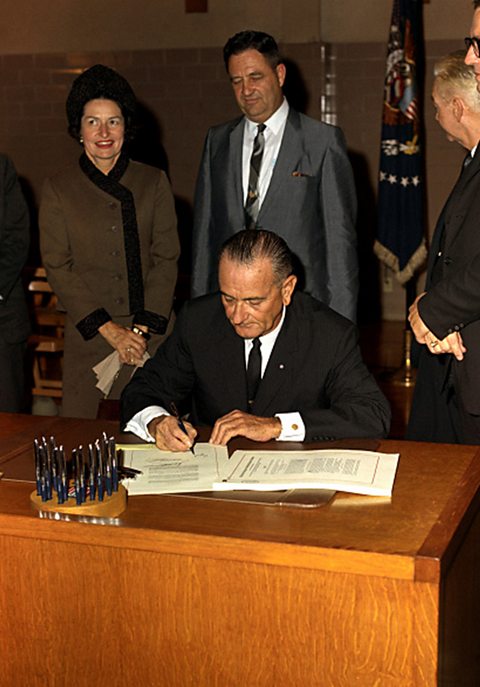A вҖҳGreat SocietyвҖҷ
Vice President Lyndon B Johnson became president automatically when President John F Kennedy was assassinated. Johnson was committed to continuing and developing the work of Kennedy. He wanted to create a вҖҳGreat SocietyвҖҷ and to end poverty and racial injustice.
After Kennedy died, there was a wave of sympathy. Johnson was able to use this to build on KennedyвҖҷs policies. Johnson was an experienced politician and he was able to persuade CongressThe legislative body of the US government, made up of the Senate and the House of Representatives. to get legislation passed.
The war on poverty

Johnson called for an "all-out war on poverty" and put forward a range of policies that aimed to reduce economic inequality across America. His vision of a Great Society included measures on:
- poverty
- civil rights
- transportation
- urban renewal
- the environment
- healthcare reform
- education reform
In November 1964, Johnson was elected president in his own right. He won the election by a large margin and this victory gave him a strong mandateWhen a political leader or party has been given approval to do something by the voters. for his own social reform programme. The following anti-poverty programme measures were part of JohnsonвҖҷs attack on poverty:
- The 1964 Economic Opportunity Act allocated money to provide training, development and educational opportunities for the unemployed. It was hoped that this would help to break the cycle of poverty in deprived communities.
- The 1965 Housing and Urban Development Act was designed to combat the decline in city housing standards. The standards in housing had worsened with the increase in the number of people moving from cities to the suburbsThe outskirts of a town or city. The act provided federalPart of the government of the USA as a whole rather than relating to an individual state. funds to cities for urban renewal and established minimum housing standards.
Healthcare reform
Supporters of laissez-faireTranslated as 'leave well alone' or 'let the people choose'. A government policy of interfering as little as possible in the economy. and the American Medical Association had been powerful opponents of healthcare reform since the New Deal. However, Johnson was able to overcome their objections and pass two key measures under the 1965 Medicare and Medicaid Act. These provided a safety net for the most vulnerable:
| Measure | Description |
| Medicare | This covered the cost of healthcare for the elderly if they qualified. |
| Medicaid | This covered the cost of healthcare for people on low incomes and the unemployed. |
| Measure | Medicare |
|---|---|
| Description | This covered the cost of healthcare for the elderly if they qualified. |
| Measure | Medicaid |
|---|---|
| Description | This covered the cost of healthcare for people on low incomes and the unemployed. |
Education
Johnson had been a teacher before he began his political career. He made education a key aspect of his war on poverty. Johnson believed that education offered a way out of poverty by providing children with more opportunities and improved standards. His reforms attempted to help children in all stages of education.
| Reform | Description |
| Operation Head Start | This was a programme intended to meet the needs of pre-school children from low-income families. |
| 1965 Higher Education Act | This act increased funding to colleges and universities. It also created scholarships and provided low-interest loans to students. |
| 1965 Elementary and Secondary Education Act | This provided major funding for education in school districts where the majority of students came from low-income families. This made education a federal responsibility. The funding was used to buy resources and for teachersвҖҷ professional development. This act was one of the most comprehensive federal laws on education ever passed by Congress. |
| Reform | Operation Head Start |
|---|---|
| Description | This was a programme intended to meet the needs of pre-school children from low-income families. |
| Reform | 1965 Higher Education Act |
|---|---|
| Description | This act increased funding to colleges and universities. It also created scholarships and provided low-interest loans to students. |
| Reform | 1965 Elementary and Secondary Education Act |
|---|---|
| Description | This provided major funding for education in school districts where the majority of students came from low-income families. This made education a federal responsibility. The funding was used to buy resources and for teachersвҖҷ professional development. This act was one of the most comprehensive federal laws on education ever passed by Congress. |
Assessments of JohnsonвҖҷs presidency
There were various opinions about JohnsonвҖҷs presidency. His supporters claim that he made American a better and fairer society.
However, Johnson faced opposition because of AmericaвҖҷs involvement in the Vietnam War. It was costly and unpopular, with many student protests against the draft system, which was a form of conscriptionA system where people are required to join a countryвҖҷs war effort by law.